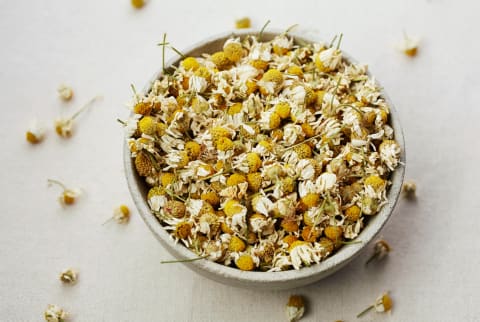Advertisement
5 Edible Flowers That Can Help Support Your Gut & Make Dishes More Beautiful


There are few things more appealing than having a multisensory food experience. When flavor, texture, appearance, fragrance, and beauty come together on your plate—the result is sheer culinary delight. One fantastic way to elevate the loveliness of a dish is with edible flowers, which are used in various cultures worldwide.
Beyond adding a dash of whimsy to the plate, edible flowers have also been traditionally used for their potential health benefits1. "Flowers that you can eat—like nasturtiums, hibiscus, lavender, and dandelions, among others—often have some therapeutic benefit," says nutritionist Ginger Hultin, M.S., RDN, author of Anti-Inflammatory Diet Meal Prep. "They contain vitamins, minerals, and are a source of fiber."
Edible flowers, or flowers that are grown in a food-safe, pesticide-free manner, can be a nutritious complement to your meal (usually, the more intensely colored flowers, the better). "They boast beneficial plant-derived compounds, like phytonutrients, that have antioxidant and anti-inflammatory properties," says mindbodygreen's supplement editor Molly Knudsen, M.S., RDN.
When it comes to gut-friendly blooms, "studies on edible flowers' direct impact on human health are lacking, but some flowers have compounds that may offer some digestive relief," says Knudsen. Time-honored herbal remedies such as chamomile, chicory, fennel, and lavender have been used to relieve indigestion and soothe other gastrointestinal-related issues. "All of these edible flowers are commonly consumed as herbal teas, or dried flowers steeped in hot water, which can also be a way to reap their digestive benefits," Knudsen adds.
Whether you are a seasoned gardener or an innovative cook, these healthful blooms can add a touch of brightness to any dish or drink—and they may offer some perks for your belly, too:
Fennel (Foeniculum vulgare)
"Fennel seeds and flowers are primarily known for improving digestion2 and calming gut irritation," says Hultin. That's because fennel may help ease the muscles in the digestive tract—plus, it's high in fiber, which helps support overall digestive health and function. Studies have indicated this plant may also offer antimicrobial, antiviral, and anti-inflammatory properties3.
Fennel's yellow, licorice-tasting florets are a flavorful addition to salads, soups, baked goods, or herbal brews.
Calendula petals (Calendula officinalis)
Beyond its superstar role in skin care, calendula blossoms (also known as marigolds) can offer a burst of sunshine to your meals. Calendula has been used by a variety of cultures for centuries, including Ayurveda and traditional Chinese medicine, for potential anti-inflammatory4 benefits.
To use, sprinkle these gold-orange petals on top of your favorite salad, soup, or turmeric latte recipes, to name a few.
Dandelion blossoms (Taraxacum officinale)
These golden blossoms are nutritious edible flowers beloved by herbalists, gourmets, and culinary devotees alike. Their bioactive chemical compounds5 have been touted for diuretic6, liver-supporting7, and anti-inflammatory8 benefits, among others. Some research has even found the dandelion plant may increase Lactobacillus and Bifidobacterium7, two valuable types of probiotics associated with gut health.
In addition to the flowers' edible versatility (dandelion flower cookies, anyone?), their leafy greens make for zesty, digestion-supportive pestos, bitters, or soup recipes, too.
Chamomile (Matricaria chamomilla)
Long-revered for its calming9 and therapeutic properties10, chamomile flowers could be an excellent tool for bolstering digestive health. Some research suggests the plant may help with various gastrointestinal disturbances11 like flatulence, indigestion, diarrhea, anorexia, motion sickness, nausea, and vomiting.
To use chamomile's daisy-like flowers, consider steeping in hot water, sprinkling on top of oatmeal, or studding into a smoothie.
Nasturtium (Tropaeolum majus)
Nasturtium's flashy-looking flowers have been a part of traditional medicine practices in Iran, Azerbaijan, Morocco, and Mauritius for many years. And for good reason—many pharmacological studies have suggested these eye-catching blooms may have antioxidant, antibacterial, and anti-inflammatory properties12. Due to their rich phytochemical content, nasturtium may help support digestive function13, too.
They offer a spicy, peppery kick to any dish—try using them as a fresh garnish, infusing vinegar, or stuffing the petals with a savory medley (similar to a squash blossom).
A word of caution
If you're unsure whether a plant is edible, always double-check with a trusted resource and your primary health provider first. Not every flower is safe to eat (think wisteria or azaleas). Practice caution, and only purchase flowers marked as "edible" if you choose to buy them at your local supermarket or gourmet store.
13 Sources
- https://pubmed.ncbi.nlm.nih.gov/32889216/
- https://pubmed.ncbi.nlm.nih.gov/22010973/
- https://www.ncbi.nlm.nih.gov/pmc/articles/PMC4137549/#B30
- https://pubmed.ncbi.nlm.nih.gov/19374166/
- https://www.ncbi.nlm.nih.gov/pmc/articles/PMC5553762/pdf/RevDiabeticStud-13-113.pdf
- https://pubmed.ncbi.nlm.nih.gov/19678785/
- https://www.mdpi.com/1420-3049/22/9/1409/htm
- https://www.ncbi.nlm.nih.gov/pmc/articles/PMC5553762/
- https://pubmed.ncbi.nlm.nih.gov/29154054/
- https://www.ncbi.nlm.nih.gov/pmc/articles/PMC2995283/
- https://www.ncbi.nlm.nih.gov/pmc/articles/PMC2995283/#R34
- https://pubmed.ncbi.nlm.nih.gov/29852261/
- https://pubmed.ncbi.nlm.nih.gov/29766690/